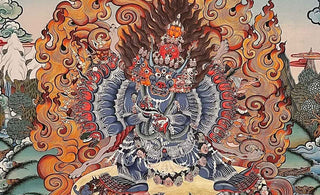
Introduction:
In the realm of Thangka art, where intricate details and vibrant colors converge to tell stories of spirituality and culture, there lies a profound undercurrent—the meditative practices that breathe life into these masterpieces. "The Sound of Silence" encapsulates not only the visual richness of Thangka art but also the silent symphony of contemplation and mindfulness that artists engage in during the creation process.
I. Thangka Art: A Visual Meditation
Thangka art, with its roots deeply embedded in Tibetan Buddhist traditions, serves as a form of visual meditation. This section explores the historical and cultural significance of Thangka paintings, highlighting their role as tools for spiritual reflection and contemplation. From depictions of deities to intricate mandalas, each element is a brushstroke in the larger canvas of meditative expression.
II. The Sacred Canvas: Setting the Stage for Meditation
Delving into the artist's studio, we uncover the ritualistic aspects of preparing the canvas for Thangka art. From the choice of materials to the meditative process of priming the surface, every step is a deliberate act that sets the stage for the profound journey that follows. The silence in the studio becomes palpable as artists engage in a form of preparatory meditation, aligning themselves with the sacred task at hand.
III. Brush and Breath: The Symbiosis of Artistic Movement and Meditation
The act of painting a Thangka is not merely a mechanical process; it is a dance of the brush guided by the breath. This section explores how artists synchronize their breath with each stroke, creating a harmonious flow between body, mind, and canvas. The meditative rhythm of brushwork becomes a conduit for spiritual energy, infusing the artwork with layers of significance that extend beyond the visible surface.
IV. Mandala Meditation: Creating Sacred Geometry
Mandalas, intricate geometric patterns often found in Thangka art, serve as a focal point for meditation.
Mandalas, with their mesmerizing geometric intricacies, are not just artistic creations in Thangka art but profound gateways to meditative experiences. These intricate patterns, often radiating from a central point, transcend their aesthetic appeal to become a focal point for meditation. Within the context of Thangka art, mandalas serve as visual representations of the universe's order, offering a symbolic language that communicates the interconnectedness of all existence.
The symbolism embedded in mandalas is a rich tapestry of spiritual meanings. The concentric circles and intricate geometric shapes are not arbitrary; rather, they represent the cosmos and the eternal cycles of life, death, and rebirth. As viewers gaze upon these meticulously crafted patterns, they are invited to embark on a journey of contemplation, transcending the physical form of the mandala into a metaphysical realm.
The creation of mandalas in Thangka art is not a mechanical process but a meditative journey for the artist. Each line drawn is a deliberate step inward, a movement that goes beyond the physical act of painting to become a spiritual exploration. The artist engages in a form of sacred geometry, where every stroke carries profound significance. The repetitive nature of creating these intricate patterns becomes a form of meditation in motion, aligning the artist's mind with the cosmic order they seek to represent.
In the meditative journey of crafting a mandala, the artist often begins at the center, symbolizing the nucleus of existence. As the lines and shapes radiate outward, they mirror the expansion of consciousness and the interconnectedness of all things. The artist's contemplative state is reflected in the precision and balance of each element, as if the very act of creation is a dance with the universal forces that govern life.
Viewers, in turn, are invited to immerse themselves in the mandala's intricate details, unlocking a door to inner reflection. The meditative quality of mandalas extends beyond the canvas, creating a space for mindfulness and introspection. Observers may find themselves drawn into a state of contemplation, transcending the visual beauty to connect with the deeper spiritual dimensions embodied within the mandala.
As one contemplates the interconnected lines and shapes within the mandala, a profound realization unfolds—that the microcosm reflects the macrocosm, and the individual is intricately woven into the fabric of the universe. The mandala becomes a visual mantra, an instrument for focusing the mind and transcending the ordinary into the extraordinary realms of consciousness.
This section unravels the symbolism behind mandalas and delves into the artist's meditative journey while creating these complex structures. Each line drawn is a step inward, a meditation in sacred geometry that mirrors the cosmic order and invites viewers to contemplate the interconnectedness of all things.
V. Silence in Color: The Meditative Palette
Colors in Thangka art are not chosen arbitrarily; they hold deep symbolic meanings. This section explores the meditative process of selecting and applying colors, where each hue becomes a carrier of emotion and spirituality. The artist, in a state of meditative awareness, infuses the canvas with a spectrum of significance, creating a visual language that transcends words.
VI. The Art of Patience: Meditative Layers of Thangka Creation
Thangka art is a testament to the artist's patience and dedication. Layer upon layer, the painting evolves, and this section examines the meditative aspect of building up the artwork over time. The artist's journey becomes a meditation on impermanence, as each layer contributes to the evolving narrative of the Thangka, mirroring the impermanent nature of life itself.
Conclusion:
"The Sound of Silence: Meditative Practices in Thangka Art Creation" is a journey into the heart of a tradition where the brush becomes a tool for meditation, and the canvas transforms into a sacred space for contemplation. Thangka art is more than a visual spectacle; it is a meditation made tangible, an expression of silence that speaks volumes about the profound connection between art and spirituality. As we immerse ourselves in the intricate details of Thangka paintings, we find not only a feast for the eyes but a symphony for the soul—a symphony composed in the profound silence of meditative creation.























